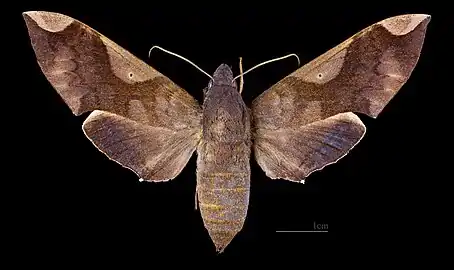| Pachylia syces | |
|---|---|
 | |
| Pachylia syces ♂ | |
 | |
| Pachylia syces ♂ △ | |
| Scientific classification | |
| Domain: | Eukaryota |
| Kingdom: | Animalia |
| Phylum: | Arthropoda |
| Class: | Insecta |
| Order: | Lepidoptera |
| Family: | Sphingidae |
| Genus: | Pachylia |
| Species: | P. syces |
| Binomial name | |
| Pachylia syces | |
| Synonyms | |
| |
Pachylia syces is a moth of the family Sphingidae.
Distribution
It is found from Mexico through Belize and Honduras to Brazil, Bolivia and Argentina.[2] It is also found on Jamaica.
Description
There is a pale median band on the forewing upperside which is separated into two patches. Occasionally the patches are connected into a continuous transverse band, but if so, the band so formed is strongly constricted. The hindwing upperside is almost unicolorous, darkened distally, without distinct bands and with a conspicuous white tip.
 Pachylia syces ♀
Pachylia syces ♀ Pachylia syces ♀ △
Pachylia syces ♀ △
Biology
There are probably multiple generations per year.
The larvae have been recorded feeding on Ficus microcarpa, Ficus prinoides, Ficus ovalis and Artocarpus integrifolius.
Subspecies
- Pachylia syces syces (Mexico through Belize and Honduras to Brazil, Bolivia, Paraguay and Argentina)
- Pachylia syces insularis Rothschild & Jordan, 1903 (Jamaica)
References
- ↑ "CATE Creating a Taxonomic eScience - Sphingidae". Cate-sphingidae.org. Archived from the original on 2012-11-12. Retrieved 2011-10-19.
- ↑ "Silkmoths". Silkmoths.bizland.com. Archived from the original on 2016-03-04. Retrieved 2011-10-19.
This article is issued from Wikipedia. The text is licensed under Creative Commons - Attribution - Sharealike. Additional terms may apply for the media files.